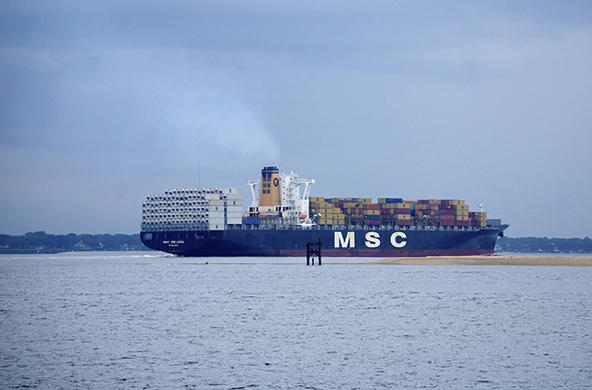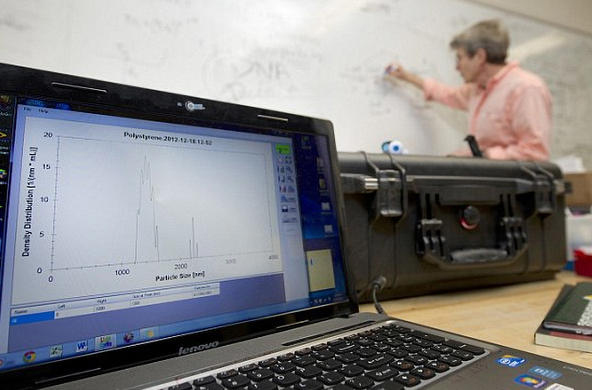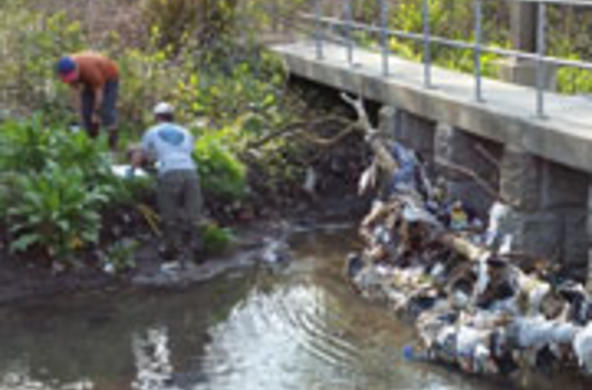Why in the world are cyanobacteria blooming in an oligotrophic lake? Back in 2005, when spotlighted author Cayelan Carey was developing her undergrad thesis project at Dartmouth College (New Hampshire, USA), she had no idea that ten years later this question would have resulted in a dedicated long-term project and a group of scientists and students that has evolved, in Cayelan’s terms, into “something much larger and more meaningful than just a research collaboration”. This entity that is beyond “just” a collaboration now refers to itself as the “Gloeo Gang”, in honor of Gloeotrichia echinulata, the culprit species in the cyanobacterial blooms.
In the first of a series of serendipitous events leading to today’s Gloeo Gang, an undergraduate Cayelan contacted the Lake Sunapee Protective Association (LSPA, lakesunapee.org), a nonprofit watershed group of energetic citizen scientists with a keen interest in their home lake (Sunapee) in New Hampshire. For her thesis project, Cayelan was interested in analyzing long-term water quality data the LSPA had been collecting. But her interests would quickly move to Gloeotrichia. At the time, co-author Kathleen Weathers, based at the Cary Institute of Ecosystem Studies, was working with the LSPA on a sabbatical project on watershed-level nutrient cycling. She suggested that Cayelan instead pursue the question of why novel and unexpected cyanobacterial blooms were occurring in the low-nutrient lake.
Cayelan enthusiastically agreed, and so began the Gloeo Gang from just three initial collaborators (including herself, her undergrad adviser Kathy Cottingham, and Kathleen Weathers). The three published a paper together in the Journal of Plankton Research, covering results from that first summer of 2005 and speculating that recruitment from dormant stages (the “seed bank”) of Gloeotrichia in the lakebed sediments during seasonal mixing might play an important role in the blooms
But they couldn’t help but wonder: How repeatable was this single-season study from one year to the next in Lake Sunapee? And: What was going on in other oligotrophic lakes in the region? [And furthermore, we suspect after finding out more about the Gloeo Gang: How can we continue our fun and well-functioning collaborative research?] As Cayelan moved from undergrad to grad to postdoc to [now] assistant professor, the Gloeo Gang grew in scope and in size to include the other co-authors on the spotlighted article (Holly Ewing and Meredith Greer from Bates College), as well as a number of student researchers. They meet regularly, both on Skype and in person, and they have to date collected weekly phytoplankton data every summer for 10 years from Lake Sunapee (the spotlighted article covering the first eight of these). They have begun studying a number of other lakes as well, although these are not included in the spotlighted paper.
The inference thus far is that the degree of mixing of the water column influences the annual likelihood of Gloeotrichia blooms, probably because greater mixing – including deeper thermoclines – increases recruitment of cyanobacteria from the sediments. And regional climatic variability could be the ultimate driver of how much mixing happens from one year to the next. Cayelan says that one of the most important take-home messages is that long-term monitoring is essential to get a handle on natural variability. Interestingly, each year has been different since her undergrad thesis in the summer of 2005! Another message we can gather from talking to Cayelan is that often an unquantifiable interaction between a well-functioning group of scientists, students, and mentors (read: the Gloeo Gang) and an intriguing study direction can result in something that transcends the sum of the parts. This intangible could be why many of us “do science” in the first place. Cayelan describes the ongoing work as a “labor of love” and with a figurative wink says she looks forward to publishing the Gloeo Gang’s 15-year research summary in FWS in a few years.






